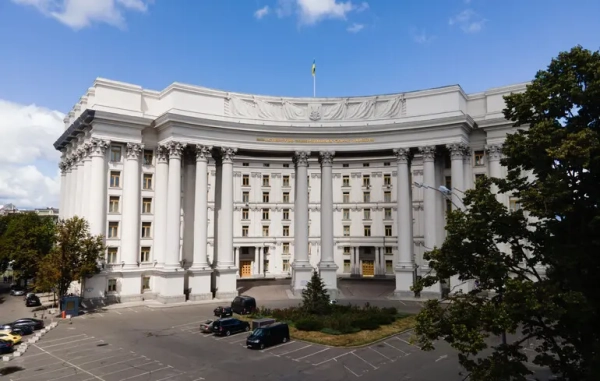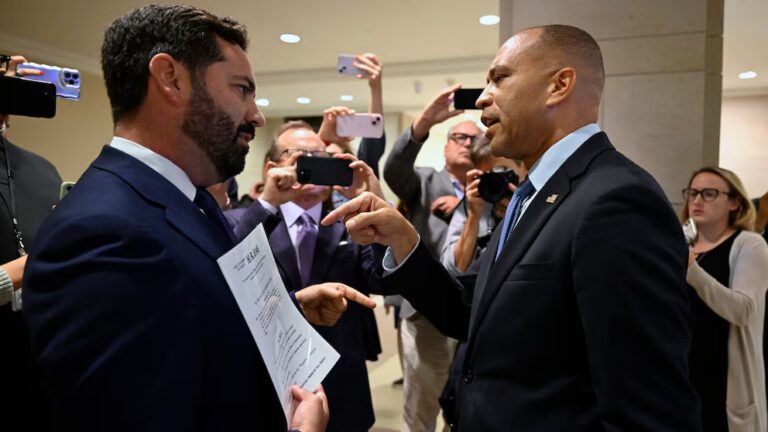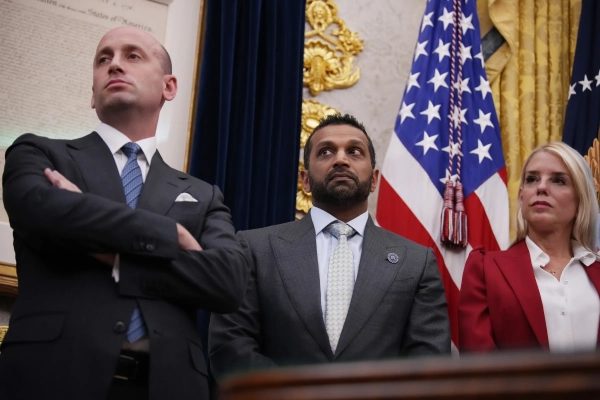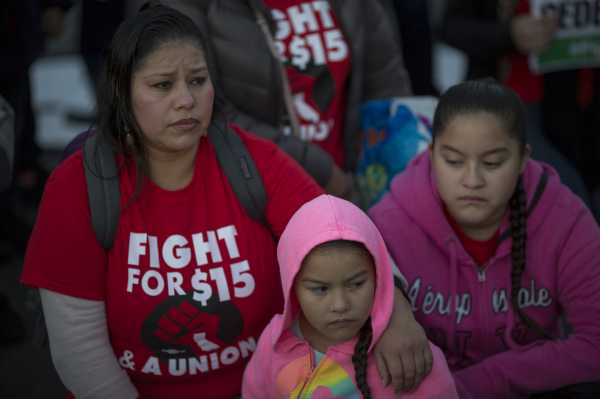
In a House hearing on monetary policy last week, Federal Reserve Chair Jerome Powell made a telling confession in response to a question from Rep. Alexandria Ocasio-Cortez (D-NY). The topic was the so-called natural rate of unemployment: the idea, believed by many economists and policymakers, that there is a rate at which unemployment could get so low that it could trigger ever-rising inflation.
It’s an idea that has governed decades of monetary policymaking, often prompting the Fed to keep interest rates higher than it should — slowing down the economy in the process — out of fear of accelerating inflation.
Ocasio-Cortez didn’t waste time poking holes at it. She pointed out that the unemployment rate, now 3.7 percent, has fallen well below the Fed’s estimates of the natural rate, which it forecast at 5.4 percent in 2014 and 4.2 percent today. And yet, she noted, “inflation is no higher today than it was five years ago. Given these facts, do you think it’s possible that the Fed’s estimates of the lowest sustainable unemployment rate may have been too high?”
Powell’s response, to his credit, was as simple and direct as you’ll ever hear from a central banker: “Absolutely.” He elaborated: “I think we’ve learned that … this is something you can’t identify directly. I think we’ve learned that it’s lower than we thought, substantially lower than we thought in the past.”
Powell’s response was commendable, perhaps even groundbreaking; here was the Fed chair challenging decades of conventional economic wisdom. It was a welcome sign of a policymaker’s willingness to question age-old assumptions that have dictated policy and affected millions.
And it’s not the only economic “iron law” that we need to revisit. In the spirit of Powell’s act, I’d like to dig deeper into some assumptions that have defined economic policymaking these past few decades, assumptions that have needlessly caused a lot of economic pain.
The natural rate of unemployment that AOC questioned is one such idea (more on that below). There are three others worth singling out:
- that globalization is a win-win proposition for all, an idea that has deservedly taken a battering in recent years;
- that federal budget deficits “crowd out” private investments; and
- that the minimum wage will only have negative effects on jobs and workers.
Economists and policymakers have gotten these ideas wrong for decades, at great cost to the public. Especially hard hit have been the most economically vulnerable, and these mistakes can certainly be blamed for the rise of inequality. It’s time we moved on from them.
1) Going below the natural rate of unemployment could spark an inflationary spiral
The mandate of the Federal Reserve is to achieve maximum employment at stable prices. It has interpreted the latter to mean an inflation rate of 2 percent. For decades, the Fed has used the benchmark interest rate it controls to target that inflation rate, and it’s done so by trying to keep actual unemployment close to its estimate of what’s called the natural rate of unemployment — a rate below which it was believed inflation would spiral up.
The problem is that the core relationship behind this model — the negative correlation between unemployment and inflation — has been weakening for years, and with it any ability to reliably estimate the natural unemployment rate. Moreover, as Powell acknowledged, there’s been an asymmetry: Because the estimates of the natural rate have been too high, the Fed has often intervened in the direction of raising or failing to cut interest rates.
The cost of this asymmetry has been steep. Since 2009, the average of the Fed’s natural rate estimate has been about 5 percent. As Powell stressed, we can’t accurately identify the natural rate of unemployment, but suppose it’s actually 3.5 percent. Targeting 5 percent unemployment when we could achieve 3.5 percent with little risk of spiraling inflation would mean 2.4 million people unnecessarily out of work. Even targeting the Fed’s current natural rate (4.2 percent) would sacrifice a million potential workers to the altar of an empirically elusive concept.
And the unemployed are just one subgroup that gets hurt in such a scenario. Much research has shown that in slack labor markets, middle- and low-wage earners lack the bargaining clout they have in tight labor markets. As such, they face lower pay, fewer hours of work, higher poverty, and wider racial economic gaps.
By contrast, high-income households are little affected — which means that labor market slack can deepen inequality. The figure below, from a recent paper by Keith Bentele and me, shows the acceleration — the difference between wage growth in strong versus weak labor markets — for real annual earnings.
For low-income workers, we found earnings rose at about a 2 percent annual pace in hot labor markets and fell at about a 4 percent pace in cool ones (the difference, 6 percent, is the first bar). Clearly, the benefits of moving from slack to taut conditions are much more important for low- than for high-earning households.
Such are the costs of over-estimating the natural rate.
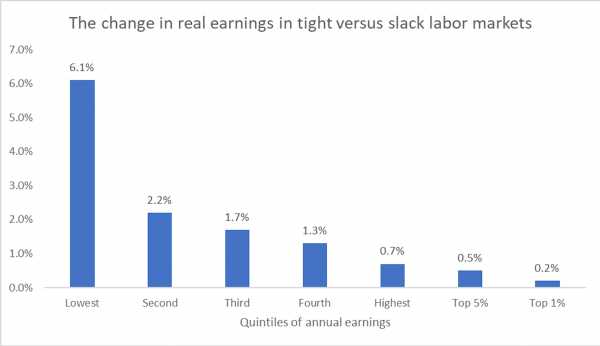
2) Everybody wins with globalization
Back in the 1990s, when the Clinton administration was trying to sell NAFTA, the view that expanded trade was virtually all upside began to pervade the rhetoric and politics of both parties. They were supported by economic arguments that exporting industries would expand into markets and add new jobs, and consumers would have cheaper goods. By dint of their superior productivity, US manufacturers and their communities wouldn’t be hurt. Any disruption to workers’ livelihoods was either dismissed as an impossibility or placed under the antiseptic rubric of “transition costs.”
This excerpt from the 1994 economic report of the president nicely captures the zeitgeist:
When pressed as to how expanded trade could truly be “win-win,” advocates like Clinton’s economics team above cited the economic theory of comparative advantage: When trading partners produce what they’re best at producing, both countries will come out ahead.
But the theory never said expanded trade would be win-win for all. Instead, it (and its more contemporary extensions) explicitly said that expanded trade generates winners and losers, and that the latter would be our blue-collar production workers exposed to international competition. True, the theory maintained (correctly in my view) that the benefits to the winners were large enough to offset the costs to the losers and still come out ahead. But as trade between nations expanded, policymakers quickly forgot about the need to compensate for the losses.
The era of free trade eventually led to large trade deficits with countries with comparatively productive factories to ours but with much lower wages, most notably Mexico and China. As in every other advanced economy, the share of US manufacturing employment had long been drifting down. But the number of US factor jobs held pretty constant around 17 million — until around 2000, when, over the next decade, almost 6 million such jobs were lost. Economists who’ve studied the period now refer to it as “the China Shock.”
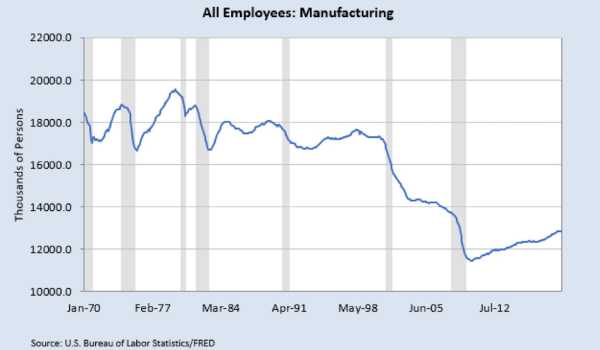
Once again, these impacts didn’t just translate into just job losses; wages were hit, too. Between the late 1940s and the late 1970s, when production workers were relatively insulated from foreign competition, blue-collar manufacturing compensation more than doubled. By contrast, it’s grown only 5 percent since then.
Did the winners from trade — the multinational corporations that relocated production, the finance sector that made the deals, the retailers that profited from “the China price” — compensate the losers? Of course not. They argued that “everyday low prices” were reward enough.
But not only did the winners fail to help the losers — say, through serious employment-replacement programs, robust safety net assistance, direct job creation, and investments to make our manufacturers more competitive — they instead used their winnings to invest in politicians to cut their taxes and write ever more trade deals favoring investors over workers.
Let me be very clear. Both the US and developing countries have significantly benefitted from global trade. But because of the demonstrably false view that free trade is all upside — win-win — considerable economic pain has been meted out, pain that has not been met with anything approaching an adequate policy response.
3) Deep budget deficits will crowd out private investment
For decades, economists argued that when the federal government runs a budget deficit, it pushes up interest rates and slows economic growth. It’s a theory known as “crowd-out,” suggesting government borrowing from a relatively fixed stock of loanable capital crowds out private borrowing, which in turn raises the cost of capital — i.e., the interest rate.
But this is yet another relationship that has failed to hold up, though not before its adherents created considerable hardship, both here and even more so in Europe, through austere budget policy in the wake of the Great Recession. The belief in this idea prompted policymakers to reduce government spending to avoid alleged crowd-out effects well before the private sector had recovered and could generate enough growth on its own.
There were certainly periods in the past when crowd-out did indeed appear in the data. The 1970s and early 1980s saw larger budget deficits (i.e., more negative) and higher interest rates. But since then, deficits have swung significantly up and down while interest rates have consistently drifted down.
Most recently, we’ve been posting very large budget deficits given the state of the economy (due to both deficit-financed tax cuts and spending) and interest rates are nonetheless hitting historic lows — precisely the opposite of crowd-out predictions.
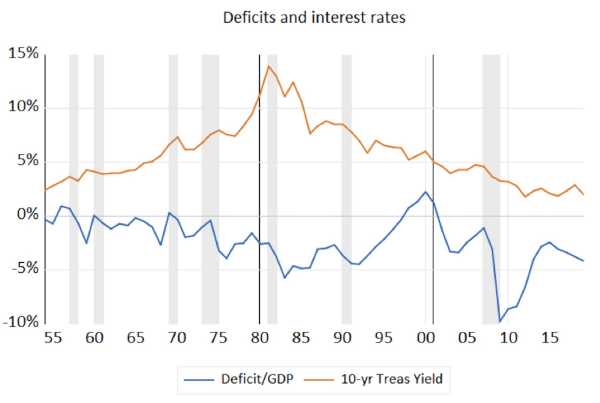
This all sounds pretty abstract, but it has stark implications on the ground. Based on the deeply embedded notion (at the time) that the deficits built up in the Great Recession needed to come down quickly, the federal government pivoted to deficit reduction well before our private sector had recovered.
As a member of the Obama economic team at the time, I can confirm that crowd-out fears were a motivation for the pivot. According to this analysis by the Brooking’s Institute, between 2011 and 2014, fiscal policy cut about 1 percentage point per year from real GDP growth. Based on the historical correlation between growth and jobs, this austerity added 2 points to the unemployment rate in those years, or about 3 million jobs.
I tend not to give Trump a lot of credit for economic policy, and I believe his tax cut will exacerbate inequality and rob the Treasury of needed revenue. But the fiscal economics of Trump’s tax cuts are revealing in ways that relate both to crowd-out and the natural rate of unemployment. As noted, deficits are up and interest rates are down. Meanwhile, the positive fiscal boost has helped drive the unemployment rate down to 50-year lows while inflation remains low and stable. These developments clearly undermine long-held economic doctrines, and they’ve been a boon to working families.
That said, a final point must be underscored: The absence of crowd-out doesn’t mean deficits no longer matter. Even with low rates, we’ll still be devoting more tax revenue to financing our debt, and even more worrisome is the fact that we’re almost certain to enter the next recession with a debt-to-GDP ratio that’s twice that of the historical norm. This will likely lead Congress to be more timid in fighting the next recession. But this is a political constraint, not an economic one.
4) A higher minimum wage will only hurt workers
Another big mistake with lasting consequences has been the assumption that minimum wage increases will hurt their intended beneficiaries: low-wage workers.
The theory is that free markets set an “equilibrium” wage that perfectly matches supply and demand given employers needs and workers’ capabilities. Force that equilibrium wage up and rampant unemployment will result.
When I was coming up in the profession, our textbooks argued that believing minimum wages could help low-wage workers was akin to believing that water flowed uphill. Their message was particularly comforting to conservative politicians who wanted to protect the profits of employers of low-wage workers.
Today, decades of high-quality research (much of it initiated by the late, great economist Alan Krueger) have introduced a much more nuanced view about the true impacts of minimum-wage hikes. But years of economists’ opposition to the policy have left us with a national minimum wage of $7.25 per hour, a level far too low to support the many families that depend on the minimum wage. (Another myth was that only teenagers earned the minimum; David Cooper’s work shows the main beneficiaries of higher minimum wages are working adults.)
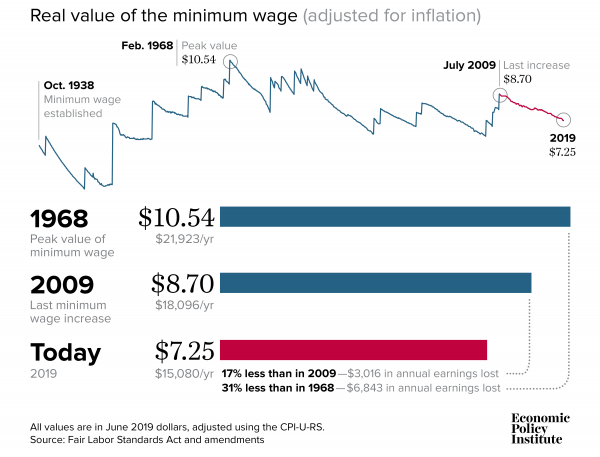
How the consensus began to change is instructive. To their credit, some state policymakers decided to ignore the economists and raise minimum wages in their states. This provided researchers like Krueger with quasi-natural experiments of a type too rare in economics. The positive results of these studies led many more states and cities to raise their wage floors (29 states plus DC now have minimums above the federal level), and this fed back into the experimental research, creating a powerful loop.
Summarizing a large and still contentious body of research, a fair conclusion is that, conditional on their magnitude, minimum wage increases accomplish their goal of raising pay for low-wage workers without large job-loss effects. But the broader point is that an economic relationship believed to be steadfast was tested and was found wanting.
The changing consensus can be seen in a new report from the Congressional Budget Office — a bastion of mainstream economics — that found an increase in the minimum wage to $15, phased in by 2025, would benefit 27.3 million workers, with an average gain of $1,500 per year, reduce the number of the poor by 1.3 million, but also cut employment of affected workers by 1.3 million. Yes, some would lose jobs, but so many more would benefit — hardly the “everybody loses” prediction that prevailed among economists for decades.
What all these economic mistakes have in common
Pegging the “natural rate” too high, ignoring the harm from exposure to international competition, austere budget policy, low and stagnant minimum wages — all of these misunderstood economic relationships have one thing in common.
In every case, the costs fall on the vulnerable: people who depend on full employment to get ahead; blue-collar production workers and communities built around factories; families who suffer from austerity-induced weak recoveries and under-funded safety nets, and who depend on a living wage to make ends meet. These groups are the casualties of faulty economics.
In contrast, the benefits in every case accrue to the wealthy: highly educated workers largely insulated from slack labor markets, executives of outsourcing corporations, the beneficiaries of revenue-losing tax cuts that allegedly require austere budgets, and employers of low-wage workers.
In this regard, there is a clear connection between each one of these mistakes and the rise of economic inequality.
I cannot overemphasize the importance of recognizing who benefits and who loses from these economic mistakes, because that difference is why these mistakes persist. Every one of the wrong assumptions described here benefits conservative causes, from reducing the bargaining clout of wage earners, to strengthening the hand of outsourcers and offshorers, to lowering the labor costs of low-wage employers. These economic assumptions are thus complementary to the conservative agenda and that, in and of themselves, makes them far more enduring than they should be based on the facts.
It is no coincidence that the assumptions are being so rigorously questioned by a new group of highly progressive politicians, like Rep. Ocasio-Cortez. They are making the critical connections in our political economy to challenge old assumptions that have hurt working people for too long. The vast majority of us will be better off for their work.
Jared Bernstein is a senior fellow at the Center on Budget and Policy Priorities and was the chief economic adviser to Vice President Joe Biden from 2009 to 2011.
Sourse: vox.com
